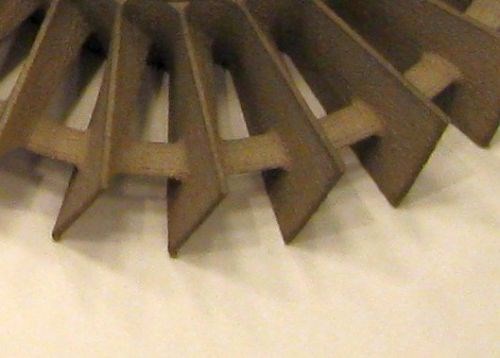ExOne: 3 Reasons Why Additive Will Advance
At the recent Rapid show in Atlanta, Pete Zelinski talked with ExOne President David Burns about why additive manufacturing is destined to grow.

This photograph says a lot about additive manufacturing. The part that is partially shown here (its hub is proprietary) was 3D printed in metal by ExOne—a company that supplies both additive manufacturing equipment and additive manufacturing services.
David Burns, the company’s president, says the original 3D-printed version of this component was nearly a replica of the part that used to be generated through machining. The fins were thicker to ensure rigidity. It gradually became clear to the customer that this thickness wasn’t necessary. The extra stock was a concession to the manufacturing method.
A better design used the retainer ring seen in the photo to secure the fins instead. Using the ring allowed the fins to be thinner, producing a lighter and more material-efficient part. This ring was not considered initially because the previous production methods offered no practical way to produce it. 3D printing provided the freedom to begin exploring non-conventional designs.
Mr. Burns says the example of this component illustrates two major reasons why additive manufacturing is destined to grow as an option for part production.
One, it unlocks design possibilities. Manufacturers first exposed to 3D printing often do not appreciate just how many of the design constraints they are accustomed to accepting are actually constraints of traditional production processes.
Two, he says, additive manufacturing makes complexity cheap. An intricate form is just as easy to produce through 3D printing as a simple one. In fact, the intricate form might be less expensive than the simple form because the simple form is liable to use more material. Designs can be changed easily and frequently, without concern for how these changes might affect production hardware such as mold tooling.
Mr. Burns says a third reason to expect additive manufacturing to advance is seen not in the part, but in where the part is produced. Additive manufacturing is inherently local, he says. The benefits it provides in terms of flexibility and responsiveness deliver their highest value when the parts are printed very close to where they will be used, eliminating transportation, storage and spare part costs.
Related Content
-
Implicit Modeling for Additive Manufacturing
Some software tools now use this modeling strategy as opposed to explicit methods of representing geometry. Here’s how it works, and why it matters for additive manufacturing.
-
NIOSH Publishes 3D Printing Safety Guide for Nonindustrial Settings
NIOSH has published a 3D printing safety guide for small businesses and other additive manufacturing users such as makerspace users, schools, libraries and small businesses.
-
Video: Intelligent Layering Metal 3D Printing at 3DEO
Contract manufacturer 3DEO delivers metal parts using Intelligent Layering, a binder jetting-like 3D printing process the company developed and operates internally. Here’s how it works.








